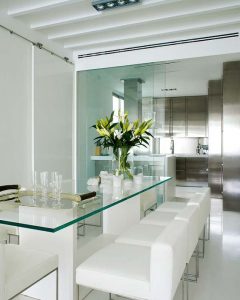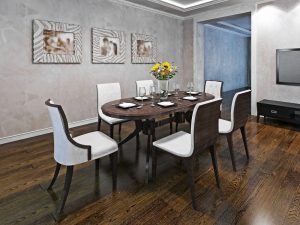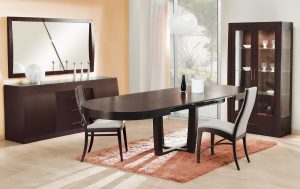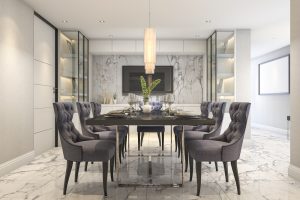Ideas for Dining Room Tables

In the long run, a dining room table that is too small could cause problems. However, a larger table may not be entirely necessary.
This post will review several of the available dining room table options. We’ll help you choose the dining room table that is best for the needs of your family and your lifestyle.
Shape
The shape and size of your dining room will affect the shape of your dining table. Proportions are a vital factor to bear in mind when trying to create the perfect space.
A dining room table can come in four different shapes:
Square
By opting for a square table, you can focus on its design and be more inventive. These tables are very good-looking and don’t go unnoticed.
When you’re sat at a square table, you can also see all your dinner guests from your seat. This means you can easily converse with everyone throughout your meal.
Round
Round tables work perfectly in the center of your room. Similarly to square tables, round tables also allow dinner guests to easily talk to each other.
Rectangular
These are the most common dining tables as they best fit the space available.
The benefit of rectangular dining tables is that they provide more room to accommodate many dinner guests.
Oval
These tables are a more natural shape. They combine the functionality of a rectangular table with the smooth lines of a round one.
One thing to bear in mind, however, is that the guests seated at the ends will have less space for their dinnerware. This may leave them feeling uncomfortable.

Functionality
This is one of the key features that we should be looking for in a dining table.
When choosing the perfect dining table, it’s worth considering your family’s needs (how much time you spend at the dinner table, the size of your family, etc.) You should also bear in mind how often you have people for dinner.
In terms of functionality, there are two types of dining table available:
- Fixed tables: As is suggested by the name, these tables can’t be extended if you have more dinner guests than usual.
- Extendable tables: These tables are more practical and they are perfect for having guests for dinner and for saving space.
Types of extendable dining table:
- Tables that extend with a circular leaf: These are typically round tables and they really stand out. Only the surface of the table extends, so the legs stay where they are.
- Tables that extend with a central leaf: To extend this type of table, all you need to do is pull away the ends to reveal the middle section and place this in the center, completing the table. Some versions can also be quite flexible in that the size of the gap can be adapted.
- Tables that extend with leaves at either end: These are quite common, however, the ends can sometimes become unstable as they do not have any supports attaching them to the ground.
- Tables that extend when spun: These are usually round or oval tables that extend at either end.
- Tables that extend from a console table: Is it possible for a table to be both a dining table and a console table? It certainly is! These are great for smaller spaces and perfect if you only need a dining table when you have guests. The rest of the time, they tidy away into a neat console table.

Legs do matter
We often focus on the surface or the shape of our dining room tables, but we forget the legs underneath.
A dining room table’s legs are important as they are its only supporting structure. It’s vital to take these into consideration when choosing your perfect table.
However, as you will see below, there are table legs available to suit any taste.
- Central table leg: The key feature of these legs is that they’re strong enough to support the weight of the entire table. Their main advantage is that they leave clear leg room underneath the table to ensure guests can sit comfortably.
- Table legs at either end: These are the most commonly-used legs and the most practical, given they also leave clear space underneath the table. If the table is quite large, it’s better to ensure that the table has another supporting leg.
- Table legs positioned at an offset angle: These legs are, architecturally, quite stylistic, as well as strong. They go well with both industrial and modern designs. Their only disadvantage is that they take up space underneath the table. This means two of your guests will always need to sit at the head of the table at either end.
- Side U-shaped table legs: These legs provide good stability and a very modern design.
- Easel table legs: Visually, these legs are quite appealing and perfect if you wish to create a Nordic style in your dining room. However, they can take up leg room underneath the dining table and leave guests feeling uncomfortable, so they are less practical.

Conclusion
It’s clear that there are several important factors to bear in mind when choosing the right dining room table.
Once you have decided on the right shape, the functionality you need in your table and your preferred table legs, you then need to think about your preferred materials and colors.
Remember, design and functionality should always go hand-in-hand. However, you are the one who decides which of these is the predominant feature of your dining room table.
In the long run, a dining room table that is too small could cause problems. However, a larger table may not be entirely necessary.
This post will review several of the available dining room table options. We’ll help you choose the dining room table that is best for the needs of your family and your lifestyle.
Shape
The shape and size of your dining room will affect the shape of your dining table. Proportions are a vital factor to bear in mind when trying to create the perfect space.
A dining room table can come in four different shapes:
Square
By opting for a square table, you can focus on its design and be more inventive. These tables are very good-looking and don’t go unnoticed.
When you’re sat at a square table, you can also see all your dinner guests from your seat. This means you can easily converse with everyone throughout your meal.
Round
Round tables work perfectly in the center of your room. Similarly to square tables, round tables also allow dinner guests to easily talk to each other.
Rectangular
These are the most common dining tables as they best fit the space available.
The benefit of rectangular dining tables is that they provide more room to accommodate many dinner guests.
Oval
These tables are a more natural shape. They combine the functionality of a rectangular table with the smooth lines of a round one.
One thing to bear in mind, however, is that the guests seated at the ends will have less space for their dinnerware. This may leave them feeling uncomfortable.

Functionality
This is one of the key features that we should be looking for in a dining table.
When choosing the perfect dining table, it’s worth considering your family’s needs (how much time you spend at the dinner table, the size of your family, etc.) You should also bear in mind how often you have people for dinner.
In terms of functionality, there are two types of dining table available:
- Fixed tables: As is suggested by the name, these tables can’t be extended if you have more dinner guests than usual.
- Extendable tables: These tables are more practical and they are perfect for having guests for dinner and for saving space.
Types of extendable dining table:
- Tables that extend with a circular leaf: These are typically round tables and they really stand out. Only the surface of the table extends, so the legs stay where they are.
- Tables that extend with a central leaf: To extend this type of table, all you need to do is pull away the ends to reveal the middle section and place this in the center, completing the table. Some versions can also be quite flexible in that the size of the gap can be adapted.
- Tables that extend with leaves at either end: These are quite common, however, the ends can sometimes become unstable as they do not have any supports attaching them to the ground.
- Tables that extend when spun: These are usually round or oval tables that extend at either end.
- Tables that extend from a console table: Is it possible for a table to be both a dining table and a console table? It certainly is! These are great for smaller spaces and perfect if you only need a dining table when you have guests. The rest of the time, they tidy away into a neat console table.

Legs do matter
We often focus on the surface or the shape of our dining room tables, but we forget the legs underneath.
A dining room table’s legs are important as they are its only supporting structure. It’s vital to take these into consideration when choosing your perfect table.
However, as you will see below, there are table legs available to suit any taste.
- Central table leg: The key feature of these legs is that they’re strong enough to support the weight of the entire table. Their main advantage is that they leave clear leg room underneath the table to ensure guests can sit comfortably.
- Table legs at either end: These are the most commonly-used legs and the most practical, given they also leave clear space underneath the table. If the table is quite large, it’s better to ensure that the table has another supporting leg.
- Table legs positioned at an offset angle: These legs are, architecturally, quite stylistic, as well as strong. They go well with both industrial and modern designs. Their only disadvantage is that they take up space underneath the table. This means two of your guests will always need to sit at the head of the table at either end.
- Side U-shaped table legs: These legs provide good stability and a very modern design.
- Easel table legs: Visually, these legs are quite appealing and perfect if you wish to create a Nordic style in your dining room. However, they can take up leg room underneath the dining table and leave guests feeling uncomfortable, so they are less practical.

Conclusion
It’s clear that there are several important factors to bear in mind when choosing the right dining room table.
Once you have decided on the right shape, the functionality you need in your table and your preferred table legs, you then need to think about your preferred materials and colors.
Remember, design and functionality should always go hand-in-hand. However, you are the one who decides which of these is the predominant feature of your dining room table.







